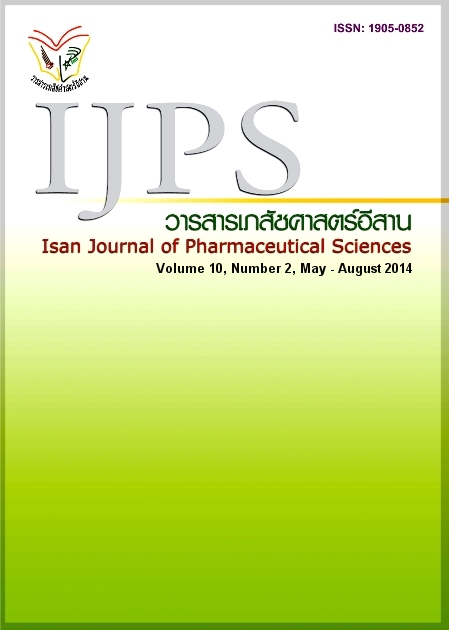Impacts of Esomeprazole Injection Control Policy on Utilization and Expenditure in Mahasarakham Hospital
Main Article Content
Abstract
Introduction: Esomeprazole is a non-essential drug which is expensive. In Mahasarakham hospital, utilization of and expenditure for esomeprazole injection are increasing. Therefore, in December 2012, the hospital introduced a policy to control use of esomeprazole injection. The objective of this study is to assess the impact of the policy. Methods: Data on esomeprazole utilization and expenditure in in-patient department during October 2011 to September 2013 were obtained. Utilization and expenditure were defined as vial and baht per gastrointestinal (GI) patient, respectively. Changes in level and trend were examined by segmented regression of interrupted time series (ITS) analysis. Results: esomepraozole utilization and expenditure declined from 6.2 to 4.1 vial/GI patient/month (33.9% reduction) and from 2,198 to 1,462 baht/GI patient/month (33.5% reduction), respectively, but omeprazole and pantoprazole utilization and expenditure increased. From ITS analysis, the policy statistically associated with changes in level and trend of esomeprazole use (utilization: level change -1.79 vial/GI patient/month (95%CI: -3.06 to -0.51) and trend change -0.21 vial/GI patient/month (95%CI: -0.40 to -0.03) and expenditure: level change -630.65 baht/GI patient/month (95%CI: -1,080.52 to -180.78) and trend change -75.64 baht/GI patient/month (95%CI: -140.69 to -10.60)). Conclusion: The drug control policy has significantly impacted both utilization of and expenditure for the study drugs. To efficiently control health expenditure, expensive substitute drugs should be considered and also controlled.
Article Details
In the case that some parts are used by others The author must Confirm that obtaining permission to use some of the original authors. And must attach evidence That the permission has been included
References
Albeldawi M, Qadeer MA, Vargo JJ. Managing acute upper GI bleeding, preventing recurrences. Cleve Clin J Med 2010; 77: 131-42.
Alemayehu B, Ke X, Youssef NN, Crawley JA, Levine DS. Esomeprazole formulary exclusion: impact on total health care services use and costs. Postgrad Med 2012; 124: 149-63.
Ansari F, Gray K, Nathwani D, Phillips G, Ogston S, Ramsay G, et al. Outcomes of an intervention to improve hospital antibiotic prescribing: interrupted time series with segmented regression analysis. J
Antimicrob Chemother 2003; 52: 842-8.
Bardou M, Martin J, Barkun A. Intravenous proton pump inhibitors: an evidence-based review of their use in gastrointestinal disorders. Drugs 2008; 69: 435-48.
Boocha K, Lamlong P, Klangphukhieo S, Chaiyasong S, Chaiyasong C, Rattanachotpanit T. Patterns of Esomeprazole injection use in Mahasarakham hospital. IJPS 2014; 9S: 55-60. [in Thai]
Bureau of Policy and Strategy Offi ce of Permanent Secretary. Prescribing information of the 31 hospitals in fi scal year 2009. Nonthaburi: Bureau of Policy and Strategy Offi ce of Permanent Secretary, 2010. [in Thai]
Chaiyasong S, Chaiyasong C, Rattanachotpanit T, Sawangdee O, Klangphukhieo S, Lamlong P. Patterns of Esomeprazole injection use in Mahasarakham hospital. Maha Sarakham: Faculty of Pharmacy, Mahasarakham University. 2013. [in Thai]
Development Subcommittee of the National Essential Drug List. Guide for reasonable drug use: the national essential drugs of gastrointestinal drugs, volume 1. Nonthaburi: The Agricultural Co-operative Federation of Thailand, 2009. [in Thai]
Drug and Medical Inventory of Department of Pharmacy, Mahasarakham hospital. Report of drug use value during March - June 2012. Drug and Medical Inventory of Department of Pharmacy, Mahasarakham
hospital, 2012. [in Thai]
Hsu JC, Lu CY, Wagner AK, Chan KA, Lai MS, Ross-Degnan D. Impacts of drug reimbursement reductions on utilization and expenditures of oral antidiabetic medications in Taiwan: An interrupted time series study. Health Policy 2013. [http://dx.doi.org/10.1016/j.healthpol.2013.11.005].
Kirchheiner J, Glatt S, Fuhr U, Klotz U, Meineke I, Seufferlein T et al. Relative potency of proton pump inhibitors–comparison of effects on intragastric pH. Eur J Clin Pharmacol 2009; 65: 19-31.
Klotz U. Proton-pump inhibitors–their pharmacological impact on the clinical management of acid-related disorders. Arzneimittelforschung 2009; 59: 271-82.
Lagarde M. How to do (or not to do). Assessing the impact of a policy change with routine longitudinal data. Health Policy Plan 2012; 27: 76-83.
Lagarde M, Palmer N. The impact of user fees on health service utilization in low- and middle-income countries: how strong is the evidence? Bull World Health Organ 2008; 86: 839-48.
Limwattananon S, Limwattananon C, Cheawchanwattana A, Silkavute P, Tangcharoensatien V. Forecasted expenditure due to the use of expensive drugs in Civil Servant Medical Benefi t Scheme: a comparison
with Universal Health Coverage Scheme. Journal of Health Systems Research 2011; 5: 170-180. [in Thai]
Nasser SC, Nassif JG, Mahfouz. Cost reduction associated with restriction policy on dispensing intravenous esomeprazole in Lebanon. Pharm World Sci 2010; 32:707-10.
Penfold RB, Zhang F. Use of interrupted time series analysis in evaluating health care quality improvements. Acad Pediatr 2013; 13: S38-44.
Wagner AK, Soumerai SB, Zhang F, Ross-Degnan D. Segmented regression analysis of interrupted time series studies in medication use research. J Clin Pharm Ther 2002; 27: 299-309.


